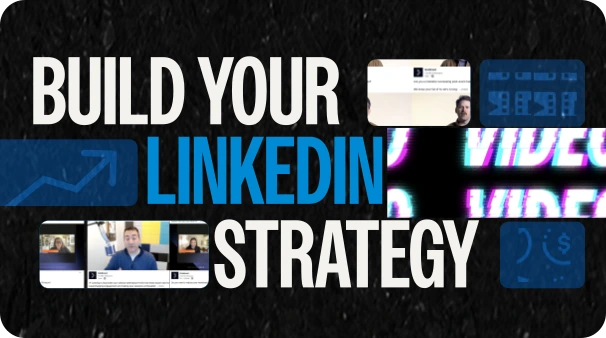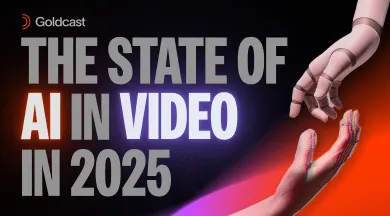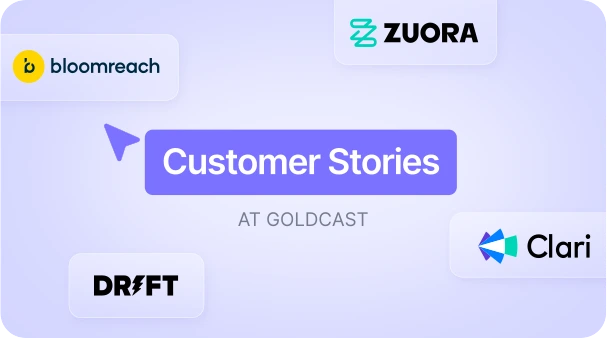Lights, Camera, Collaboration: Strengthening Teams with Internal Video Communication

Table of Contents
Maximize Your Marketing ROI
Join 10,000 other marketers already getting the best tips on running engaging events that boost pipeline and create raving fans.
The days of the corporate memo are behind us. Unlike cheesy stock footage or clunky email attachments, internal videos that are built and scaled in-house give employees the authentic connection they crave. Done right, they can even be the glue that keeps strategy and execution aligned.
With a range of internal communication video ideas to help you onboard, train, and inspire, you can create the kind of working culture we all want to be a part of. In this article, we’ll share practical tips and examples from brands like Adobe, Gong, and Intuit to help you build your own internal video comms strategy.
7 types of internal communication videos + examples
The way employees consume content has changed. Like customers, team members start their days with Reels and podcasts, and end them with Netflix and Amazon Prime.
Video is authentic, engaging, and irresistible by nature. And with the right approach, it can help you increase employee engagement and say more with less. Here are some leading examples of the core types of internal communication videos that can help you get your point across.
1. Recruitment
When it comes to recruitment videos, there’s no shortage of inspiration. In a competitive landscape where talented workers are constantly being courted by other companies, an authentic and compelling recruitment video can go a long way in positioning your brand as the one to choose and stick with.
Here are some examples we love:
- Buffer’s role-specific recruitment video: This TikTok video features Tom Redman, a real hiring manager reading out some of the top benefits listed in their open role for a Growth Product Manager. Toddler on hip, Tom explains what’s unique about the role and what he's looking for in an ideal candidate. It’s personal, authentic, and offers clear answers to applicant FAQs.
- Adobe’s internship program promo video: This is one corporate video that lives up to its title. Featuring a series of testimonials from real Adobe interns, viewers get a sense that the future is wide open, while learning real stories of how young talent has progressed in their careers.
- Zendesk’s corporate recruitment video: With warm colors, smiles and a friendly narrator that speaks directly to the viewer, Zendesk’s This is Zendesk video makes potential applicants feel like they’re getting a real sense for who (not just what) Zendesk is. By sharing shots of Zendesk workers in the office, across the world, and at home with their families, it’s clear that they have a strong culture—even as a distributed team.
2. Employee onboarding
According to research, only 12% of employees say their company does a good job onboarding. Meanwhile, demand for workers remains high and if top-performing employees don’t find the experience they’re looking for at your company, they will leave.
We love this video from Bolt because it’s inspiring, values-driven, and could double nicely as a recruitment and onboarding asset for new employees. In We are Bolt, real team members share real data and experiences to paint a picture of the Estonian startup’s path to becoming the fastest-growing tech company in Europe.
Its “cast” includes team members spanning a range of departments, including marketing, operations, product, engineering and more. Viewers get insight into some of the key milestones and company stats, like its 10M additional users every two months, increased headcount, and footprint in over 74 cities.
The video is well-branded and produced, yet still feels authentic. Traditional onboarding videos leave a lot to be desired, but lines like this one delivered by Bolt’s Product Strategy Manager, Aastha Yadav make it crystal clear what the company values:
“How did we do it? We don’t spend time on bureaucracy. Instead, we move fast in small teams. Teams where everybody acts like an owner.”
3. Training videos
Gong’s YouTube series, How Gong uses Gong, brings the best of internal and external communication together. The videos serve as training both for employees and customers.
With bite-sized tutorials broken down by role, this on demand video playlist has something for everyone—product managers, customer success managers, sales development reps, and more. Most of the videos average around 12 minutes in length and follow roughly the same format:
- Quick intro or icebreaker
- Top 2-5 pro tips and/or use cases
- Demo of other steps/bonus tips
With a broad run of show to guide the content for this training series, Gong was able to effectively repurpose recorded webinars as on-demand YouTube videos, while making it easy for employees from other departments to add their own explainer videos.
For example, this quick video tutorial features Carolyn Dorricott’s step-by-step process for using Gong to track and overcome objections snipped from the live webinar, while this solo video from product expert Shefa Weinstein shares a quick win from her personal experience.
(Psst! Curious how the Goldcast team uses Goldcast? Get 5 event repurposing ideas tried and tested by our team.)
Create engaging internal videos in a fraction of the time. Try Content Lab today and start creating custom-branded video content using any video link or recording.
4. Anniversary videos
“Wanna watch a story?” With an opening like that, anyone who hits play on Netflix’s 25th anniversary video knows they’re in for a treat. In an epic example of brand storytelling, this two-minute video packs a powerful message into a snackable watch for viewers.
From DVDs in the mail to watching Stranger Things on-demand in Japanese, Netflix celebrates its 25-year journey into the world of streaming using humor, nostalgia, and plenty of user-generated video content.
The viewer has a front row seat to the brand’s growth story, and better yet, they feel like they’re a part of it.
5. Communicate company culture
Hybrid work, flat organizations, authentic leadership. The world of work looks a lot different than it did ten, or even five, years ago. As an internal communicator, you need to go beyond the jargon-filled talk track to frame your internal messages within a larger and more relevant context.
The goal is to make sure your videos communicate an understanding of what the viewer needs and why that’s important right now. That’s why we like this company culture video from Advidi.
Even though much of the video is set in Advidi’s corporate office, the conversations feel natural and organic. Members of Advidi’s tech team share their favorite perks, plus examples of new skills learned on-the-job that will help them keep growing long-term.
In an environment where 1 in 4 employees say they'll likely quit within the next six months due to a lack of career development support, positioning your culture within the broader conversation around what workers want could be the key to effective employee communication.
6. Interdepartmental communication
Whether it’s passing account-level insights from marketing to sales or aligning your product and customer teams around the top use cases of a recent feature release, video can help you communicate everything internal stakeholders need to know—minus the meeting fatigue.
At Goldcast, we use our own platform to create videos sharing data insights to inform our benchmarking and initiatives in quarterly review meetings.
When it comes to using video for interdepartmental communication, there’s one golden rule: talk to your team members the same way you would talk to your CEO. Keep it brief, relevant, and action-oriented with lots of data, lists, and summaries to get your point across quickly.
7. Leadership messages
When it comes to featuring your leadership team, the classic CEO interview will always have a place in the internal communication toolkit. These example interviews with David Cancel, CEO and Founder of Drift and Zeb Evans, CEO of ClickUp are just two examples of brands that use video to demonstrate authentic leadership.
But why stop there? Savvy internal communicators are using video messages to respond to changes in market conditions quickly, effectively, and in partnership with key stakeholders.
Take the team at Morningstar, for example. Before the pandemic, field sales teams were enjoying plenty of face time with buyers. So when the lockdowns hit, Nicolette Konkol, Global Head of Demand Generation at Morningstar, knew she had to help both her customers and team members make the difficult switch to remote.
She created a toolkit using their own product to help salespeople learn how to deliver high-quality virtual buying experiences. For her, the campaign was a success because it had the trifecta of effective internal communication: firsthand audience experience, a compelling external challenge, and a clear mandate from the founders.
“Those three things are a perfect recipe to galvanize your entire employee base to promote the message that you want to go to market with,” explained Nicolette in an episode of Donuts & Demand. “We actually had our own employees and our own internal subject matter experts developing content and putting that out on social channels, and then we were able to boost that content.”
Whether it’s repurposing the CEO keynote from your internal events, sharing an inspirational rally cry from your virtual sales kickoff, or getting all hands on deck in the wake of a global health crisis, the right internal communication video can help foster greater trust in leadership.
Benefits of using videos for internal communication
By delivering internal messages in a way that your team members like to receive them, you can use video to scale your internal communication far beyond what was possible in the past.
Here are just a handful of the benefits video can bring to your internal communication strategy:
- Accurate minutes and records: According to data from Loom, businesses lose over $128 billion every year because employees are wasting time trying to communicate. Videos provide a clear and accurate representation of internal discussions. And with plenty of handy AI tools on the market, you can now get a comprehensive meeting record, including a full transcript and minutes, in a fraction of the time.
- Increased engagement: Your team members are busy. And chances are, they’re probably already doing quite a bit of reading and writing in their day-to-day work. Quality video content tends to be more engaging because it captures the attention of employees quickly, offers a break from text-based content, and may even lead to better retention of information.
- Easy to repurpose: Videos can be repurposed into other formats such as written content, or social media posts, to appeal to different learning styles and allow for greater reach in your video marketing.
- Time-efficiency: According to Loom, 32% of meetings could be replaced by recorded videos. Videos have the power to convey a lot of information in a short amount of time, making them an efficient means for disseminating important messages and updates.
- Remote collaboration: Nearly 38% of employees say collaboration is better or much better when working from home. With the rise of the hybrid model, videos can be a valuable tool for keeping distributed teams connected.
- Clarity of communication: 72% of office workers say they’re frustrated with their digital communication tools. With video, visual and auditory cues help ensure clear and effective communication, reducing the likelihood of misunderstandings or misinterpretations.
- Gauge effectiveness of messaging: Through video analytics and feedback mechanisms, organizations can gauge the effectiveness of their internal messaging and make adjustments as needed to improve communication.
- Foster connection: Videos can create a sense of connection and familiarity among employees that leads to better outcomes for everyone involved. For example, Sarah McConnell of Qualified regularly meets with other teams and departments to get direct feedback that informs her campaigns.
Make a statement with your internal comms videos
Your internal videos should look just as professional as your external branding. When launching your internal communication video strategy, be sure to use strong templates, high production value, and event recordings with solid audio/visual for repurposing.
To help keep your process resource-efficient, start with a powerful tool like Goldcast. With one place for your digital events and video repurposing workflows, you can put internal video creation on autopilot.
By combining Goldcast with Content Lab, you can easily transform your virtual meetings into multiple types of video and text-based content for your training manuals, internal newsletters and emails, intranet, company blog, Slack channel, and more.
Ready to elevate your internal comms? Request a trial of Content Lab or book a demo of Goldcast today and start building a deeper connection with your teams.
Stay In Touch
Platform
Resources
Company
Community
© 2025 Copyright Goldcast, Inc. All rights reserved.



 Upcoming Events
Upcoming Events Event Series
Event Series On-Demand Events
On-Demand Events

